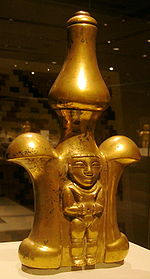
Poporo
Encyclopedia

Indigenous peoples of the Americas
The indigenous peoples of the Americas are the pre-Columbian inhabitants of North and South America, their descendants and other ethnic groups who are identified with those peoples. Indigenous peoples are known in Canada as Aboriginal peoples, and in the United States as Native Americans...
cultures in present and pre-Columbian
Pre-Columbian
The pre-Columbian era incorporates all period subdivisions in the history and prehistory of the Americas before the appearance of significant European influences on the American continents, spanning the time of the original settlement in the Upper Paleolithic period to European colonization during...
South America
South America
South America is a continent situated in the Western Hemisphere, mostly in the Southern Hemisphere, with a relatively small portion in the Northern Hemisphere. The continent is also considered a subcontinent of the Americas. It is bordered on the west by the Pacific Ocean and on the north and east...
for storage of small amounts of lime (mineral)
Lime (mineral)
Lime is a general term for calcium-containing inorganic materials, in which carbonates, oxides and hydroxides predominate. Strictly speaking, lime is calcium oxide or calcium hydroxide. It is also the name for a single mineral of the CaO composition, occurring very rarely...
. It is constituted by two pieces: the receptacle, and the lid which includes a pin that is used to carry the lime to the mouth while chewing coca
Coca
Coca, Erythroxylum coca, is a plant in the family Erythroxylaceae, native to western South America. The plant plays a significant role in many traditional Andean cultures...
leaves. Since the chewing of coca is sacred for the indigenous people, the poporos are also attributed with mystical powers and social status.
In Colombia, poporos are found in archeological remains from the Chibcha, Muisca
Muisca
Muisca was the Chibcha-speaking tribe that formed the Muisca Confederation of the central highlands of present-day Colombia. They were encountered by the Spanish Empire in 1537, at the time of the conquest...
, and Quimbaya
Quimbaya civilization
The Quimbaya civilization is a South American civilization, noted for spectacular gold work characterized by technical accuracy and detailed designs. The majority of the gold work is made in tumbaga alloy, with 30% copper, which imparts beautiful color tonalities to the pieces...
cultures among others. The materials used in the early periods are mainly pottery
Pottery
Pottery is the material from which the potteryware is made, of which major types include earthenware, stoneware and porcelain. The place where such wares are made is also called a pottery . Pottery also refers to the art or craft of the potter or the manufacture of pottery...
and carved stone. In classic periods gold
Gold
Gold is a chemical element with the symbol Au and an atomic number of 79. Gold is a dense, soft, shiny, malleable and ductile metal. Pure gold has a bright yellow color and luster traditionally considered attractive, which it maintains without oxidizing in air or water. Chemically, gold is a...
and tumbaga
Tumbaga
Tumbaga was the name given by Spaniards to a non-specific alloy of gold and copper which they found in widespread use in pre-Columbian Mesoamerica and South America.-Composition and properties:...
are the most frequent: an example of this is the Poporo Quimbaya
Poporo Quimbaya
Poporo Quimbaya is a precolumbian artpiece of the classic quimbaya period, currently exhibited in the Gold Museum in Bogotá, Colombia. Its primary use was as a ceremonial device for chewing of coca leaves during religious ceremonies...
exhibited in the Gold Museum
Gold Museum
The Gold Museum is a museum located in Bogotá, Colombia. It displays an extraordinary selection of its pre-Hispanic gold work collection - the biggest in the world - in its exhibition rooms on the second and third floors...
which is a national symbol. At the present time, the indigenous people of Sierra Nevada de Santa Marta
Sierra Nevada de Santa Marta
The Sierra Nevada de Santa Marta is an isolated mountain range apart from the Andes chain that runs through Colombia. Reaching an altitude of 5,700 metres above sea level just 42 km from the Caribbean coast, the Sierra Nevada is the world's highest coastal range...
still use poporos made with the dried fruits of a plant of genus cucurbita
Cucurbita
Cucurbita is a genus in the gourd family Cucurbitaceae first cultivated in Mesoamerica and now used in many parts of the world. It includes species grown for their fruit and edible seeds , as well as some species grown only as gourds...
(totumo), in the traditional way.

